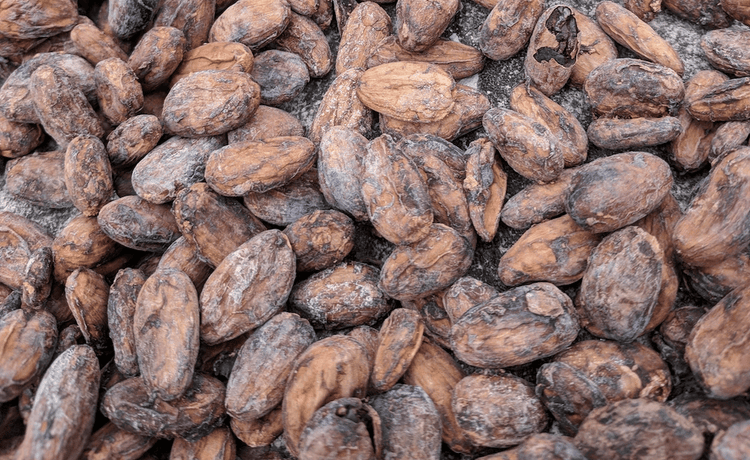The best cacao beans in the world will not produce good chocolate if the post harvest processing is not completed properly! Post harvest processing consists of cacao fermentation, cacao drying, and finally hand sorting & blending.
Navigate this article
Cacao Fermentation
The process of fermenting cacao is very delicate and needs exacting attention to produce good results.
Our partners purchase wet cacao on a weekly or biweekly basis from farmers, to incentivize farmers to only harvest perfectly ripe pods. This ensures consistent sugar levels entering the fermentation process, which helps ensure an even fermentation process. To learn more about the social impact of wet cacao purchasing, read this article.
The wet cacao is first allowed to drain excess liquid for 24 hours or so, and then it is placed in wooden fermentation boxes, approximately 3 feet on each side. About 500 lbs of wet cacao can fit in one such box.
In the first stage of fermentation, typically the first two days, anaerobic yeasts digest the sugars in the cacao fruit coating the cacao beans, and produce ethanol. The production of ethanol creates the ideal environment for acetic acid producing bacteria, which dominate the second stage of fermentation, which can last anywhere from an additional three to seven days. Cooler ambient temperatures, higher elevations, or larger cacao beans typically require longer fermentation times.
During the second stage of fermentation, the acetic acid bacteria digest the ethanol produced in the first stage, notably in the presence of oxygen, which is introduced by rotation of the cacao beans in the wooden box. This chemical reaction produces the heat that further drives the fermentation process. The fermentation is typically monitored with a temperature probe, to determine when to rotate the fermentation box, typically at least twice to introduce more oxygen to moderate the rate of fermentation. A proper fermentation will yield box temperatures of 124 degrees Fahrenheit, the same temperature as a hot shower!
Proper fermentation is one of the key steps to producing the amazing flavor in our pure 100% cacao. By contrast, industry standard fermentation can be as little as 1-2 days, resulting in poor flavor development of the cacao.
Cacao Drying
Just as important as the fermentation is the steps immediately following.
The fermentation level is assessed for completion with a cut test, in which fifty beans are randomly sampled from a lot, and cut in half with a knife. The number of under fermented, partially fermented, and well fermented cacao beans are counted, to ensure the fermentation rate meets specifications.
Once fermentation is complete, the cacao needs to be dried to stop the fermentation process. Our cacao is dried on elevated drying beds in greenhouses or direct sunshine. By contrast, industry standard is to use carbon intensive gas powered dryers, or to use tarps laid on the ground, which doesn’t allow for even airflow around the beans, risks contamination with rocks and dirt, and energetically symbolizes the cacao is of little worth.
Drying needs to proceed at a certain rate so that excess acetic acid does not get locked into the cacao beans, which produce a high level of astringency in the finished chocolate. Target moisture level is approximately 7%, which ensures that the dried cacao beans do not break in transport.
Hand Sorting & Blending
Once drying is complete, our cacao is hand sorted to remove any cacao that doesn’t meet final quality standards. Any secondary or tertiary grade cacao is sold to the local markets, and even cacao that falls off the drying beds is swept up and sold along with rocks and dirt to less discerning buyers, who bulk up cacao orders with up to 10% non cacao material. Our cacao of course is only pure cacao and has no contaminants.
As the fermentation process has so many variables, there is a naturally occurring variation in fermentation rate and the range that we shoot for is 70-90% well fermented. To achieve this range, it is common to blend lots of cacao that fall outside this range. For example a lot that is 90% well fermented could be blended with a lot that is 60% well fermented to achieve an overall rate of 75% well fermented in each bag of cacao. This blending process helps us achieve more uniform flavor across each 130lb sack of cacao.

